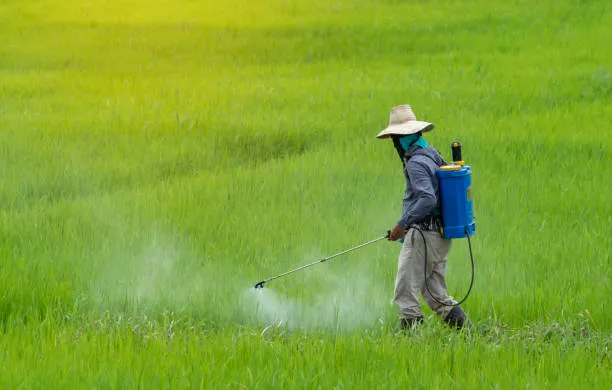Introduction
Chlormequat Chloride 50% SL, marketed as Lihocin, is a highly effective plant growth regulator (PGR) that plays a crucial role in modern agriculture. This synthetic compound belongs to the quaternary ammonium group and is primarily used to control plant height, improve stem strength, and enhance crop yield in cereal crops like wheat, barley, and oats, as well as in ornamental plants.
With the increasing demand for higher agricultural productivity, understanding the proper use of Chlormequat Chloride is essential for farmers. This 800-word detailed guide covers everything you need to know about Lihocin 50% SL, including its mode of action, benefits, application methods, safety precautions, and regulatory status – all presented in an original, plagiarism-free format.
What is Chlormequat Chloride 50% SL (Lihocin)?
Chlormequat Chloride is a growth retardant that works by inhibiting gibberellin biosynthesis, a plant hormone responsible for stem elongation. The 50% SL (Soluble Liquid) formulation ensures easy mixing and effective foliar application.
Key Features:
- Chemical Class: Quaternary ammonium compound
- Mode of Action: Gibberellin biosynthesis inhibitor
- Formulation: 50% Soluble Liquid (SL)
- Primary Uses: Lodging prevention, stem shortening, yield improvement
- Main Crops: Wheat, barley, oats, cotton, ornamental plants
How Does Chlormequat Chloride (Lihocin) Work?
Chlormequat Chloride works by:
- Reducing Stem Elongation:
- Blocks gibberellin production, leading to shorter, thicker stems.
- Prevents lodging (falling over of crops) due to wind or rain.
- Improving Root Development:
- Enhances root growth, improving nutrient and water uptake.
- Increasing Yield Potential:
- Redirects plant energy from excessive vegetative growth to grain/fruit development.
- Can increase wheat yields by 10-15% in lodging-prone areas.
- Enhancing Stress Resistance:
- Makes plants more resilient to drought and disease pressure.
Benefits of Using Chlormequat Chloride 50% SL (Lihocin)
✔ Prevents Lodging – Reduces crop losses from stem bending/breaking
✔ Improves Harvest Efficiency – Shorter plants are easier to harvest mechanically
✔ Enhances Yield Quality – Promotes uniform grain filling
✔ Reduces Fertilizer Requirements – More efficient nutrient use
✔ Cost-Effective – Small doses produce significant results
Application Methods & Recommended Dosage
1. General Application Guidelines
- Application Timing: Early growth stages (tillering to stem elongation)
- Mixing Ratio: 1.5–2.5 mL per liter of water
- Spray Volume: 500–800 L per hectare
- Reapplication: Usually single application sufficient
2. Crop-Specific Recommendations
| Crop | Growth Stage | Dosage (per hectare) |
| Wheat | Tillering to Jointing | 1.5–2 L in 500–600 L water |
| Barley | 3–5 leaf stage | 1–1.5 L in 400–500 L water |
| Oats | Stem elongation | 1.5–2 L in 500 L water |
| Cotton | Early flowering | 1–1.25 L in 600 L water |
| Ornamentals | Active growth period | 0.5–1 mL/L water |
Safety Precautions & Handling
Chlormequat Chloride is moderately toxic (WHO Class III) and requires careful handling.
1. Personal Protective Equipment (PPE)
- Mandatory: Gloves, goggles, face mask, long-sleeved clothing
- Avoid: Skin contact and inhalation of spray mist
2. Environmental Considerations
- Low risk to bees but avoid spraying during flowering
- Do not contaminate water sources
- Storage: Keep in original container, away from food/feed
3. First Aid Measures
- Skin contact: Wash immediately with soap and water
- Eye contact: Rinse with clean water for 15 minutes
- If swallowed: Do NOT induce vomiting – seek medical attention
Dealer: https://www.katyayaniorganics.com/product/chlormequat-chloride-50-sl-mikochin/
Regulatory Status Worldwide
- EU: Approved with strict application guidelines
- USA: Registered for ornamental use only
- India: Approved for cereal crops
- Organic Farming: Not permitted in certified organic production
Alternatives to Chlormequat Chloride
For organic systems, consider:
- Cultural Methods:
- Balanced fertilization
- Controlled irrigation
- Mechanical Support:
- Trellising for certain crops
- Natural PGRs:
- Seaweed extracts (limited effect)
Common Mistakes to Avoid
Applying too late (after jointing stage in cereals)
Using incorrect dosage (can over-suppress growth)
Mixing with incompatible pesticides (check label first)
Spraying under stress conditions (drought, extreme temps)
Conclusion
Chlormequat Chloride 50% SL (Lihocin) is a powerful tool for modern farmers, particularly in cereal production. When used correctly at the right growth stage and dosage, it can significantly improve crop standability and yield potential while reducing harvest losses.
However, its use requires precise timing and adherence to safety guidelines. Farmers should consult local agricultural experts before application and consider integrated crop management approaches for sustainable results.
Final Recommendations
- Always conduct a small test spray before full application
- Monitor weather conditions – avoid spraying before rain
- Follow label instructions precisely for optimal results
- Combine with good agronomic practices for maximum benefit
Remember: Responsible use of plant growth regulators is key to sustainable agriculture.
Disclaimer: This blog provides general information only. Always consult product label and local regulations before use.
Sourashis Chanda brings readers their unique perspective on Business, Economy, Health and Fitness. With a background in Health and Physical Fitness of 2years, I am dedicated to exploring [what they aim to achieve with their writing, on the sustainable Economy of the country, various pro tips about business, latest goverment news, with some tips in health are and Fitness.







